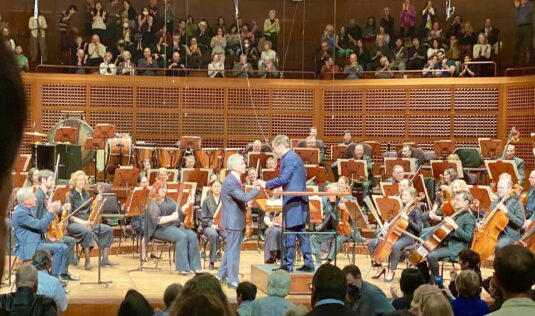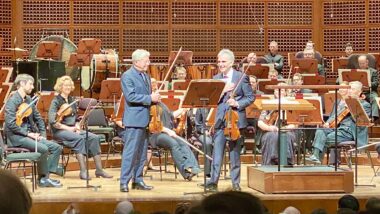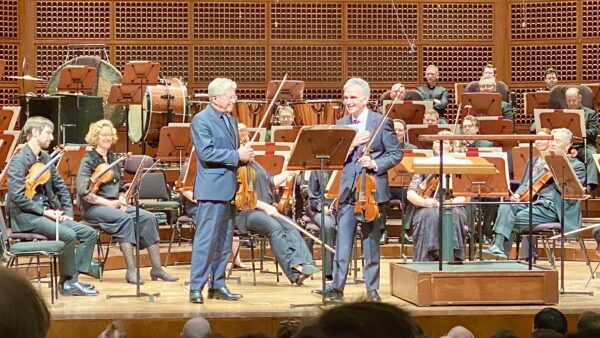 United States Brahms, Shostakovich: Gil Shaham (violin), San Francisco Symphony / Juraj Valčuha (conductor). Davies Symphony Hall, San Francisco, 30.3.2025. (HS)
United States Brahms, Shostakovich: Gil Shaham (violin), San Francisco Symphony / Juraj Valčuha (conductor). Davies Symphony Hall, San Francisco, 30.3.2025. (HS)

Brahms – Violin Concerto
Shostakovich – Symphony No.10
I seldom miss a chance to attend a concert involving the violinist Gil Shaham. It is not just his virtuosity, which is formidable – it is his ability to engage as a musical partner and to articulate a distinctive take on whatever music is in front of him. He is also catnip for audiences, exuding an honest enthusiasm for whatever is on tap.
When the orchestra carries the load musically during a concerto, he never just stands quietly as many soloists do. He turns to focus on whoever in the orchestra may have the solo line at any moment, and reacts to an orchestral flourish with a smile, a grimace or a bounce of his head in rhythm. It is clear that he feels the music.
All that was on display, along with a clear connection with conductor Juraj Valčuha, in an effectively brash performance of the Brahms Violin Concerto, in the last of three appearances with the San Francisco Symphony. Valčuha, music director of the Houston Symphony since 2022, has his own vivid approach to conducting. Although he seldom looked at the soloist, he clearly was listening, and the balances and entrances all went smoothly.
The Brahms concerto began assertively, and it signaled that this was going to be a celebration of full-throated music-making through the entire program. After the intermission came a ripsnorter of a thrill ride in the Shostakovich Symphony No.10.
The deliberate pace of the concerto’s opening, at higher volume than the pretty opening gestures we usually hear, set a different tone than one expects. Shaham’s virtuosic entrance burst out with flamboyant, Romani-style razzle-dazzle, and we were off on a wonderful sort of give-and-take between violin and orchestra that kept things shifting compellingly through the long first movement.
In another mood change, the slow movement’s languid oboe solo (played with unhurried subtlety by Eugene Izotov) set up another kind of back-and-forth with Shaham. This time it was all about intertwining the violin’s countermelodies and other gestures with the orchestra’s, eventually creating a rich tapestry before receding into a quiet reprise of the movement’s original theme. The finale, which revels in rhythmic flourishes, danced its way through to Brahms’s quixotically quiet and subdued finish.

For an encore, a stagehand brought out a music stand, and Shaham enlisted concertmaster Alexander Barantschick to play an encore – the Gavotte (Andante grazioso) from a two-violin sonata by seventeenth-century composer Jean-Marie Leclair. After the complexity of the Brahms concerto, its lightness and simplicity felt like a respite.
If there were a connection to be made between the Brahms and the Shostakovich, it might be the way that both composers stepped outside their usual modus operandi. For Brahms, it was punctuating the score with unexpected dissonances, something nineteenth-century audiences were not expecting. For Shostakovich, it was his insistent use (for the first time, according to the program note) of a motto that later showed up in several of his works as a sort of signature gesture.
A sequence of the notes (D, E-flat, C, B) spelled out an abbreviation of the composer’s name (D-S-C-H in the German system of notation). It appears in increasing frequency in the Symphony No.10, a piece that made its debut later in the same year as Stalin’s death. The Russian leader famously had vilified Shostakovich, who lived in fear of retribution. With each repetition the four-notes gained more traction, and they finally became a triumphant statement at the end of the symphony.
For his part, Valčuha, born in Slovakia but educated in Saint Petersburg, had an idea of what Shostakovich was all about and pushed tempos, emphasized accents, created contrasts in dynamics and tonal color, all the while finding connections between each episode and the next. It felt appropriate at every turn. In one section the orchestral colors shimmered and, in another, the conductor found a sort of serenity. He stirred the music up to reach harrowing climaxes.
The heroes of this excursion were the musicians of the woodwind section. Principal clarinet Carey Bell started the proceedings with a wandering tune that set a tone of uncertainty, and principal flutist Yubeen Kim delivered the first movement’s unexpectedly delicate solo against pizzicato strings. Principal bassoonist Joshua Elmore’s twisting recapitulation of the first tune spun down the first movement, and Izotov’s oboe spun out the refreshingly lovely tune that brightens the mood in the finale, sweeping aside all the foreboding that preceded it.
The woodwind section created organ-like harmonies that lent breadth and warmth to the orchestral textures. The percussion section’s contribution added a feast of extra color, whether it was the insistent snare drum that upped the ante on intensity in the first movement or the soft resonance of the tam-tam at the close of that movement. The brass punched effectively for musical exclamation points and carried off the finale’s concluding, hymn-like statement with presence.
The brief second-movement scherzo could not have been fiercer, the whole orchestra racing at a manic pace. The extended whimsy of the sweeter third movement brimmed with color. Dance and march episodes fit nicely into the finale’s fabric, and it all arrived at the finish with emphatic precision.
Harvey Steiman
